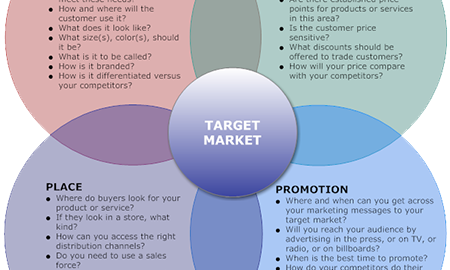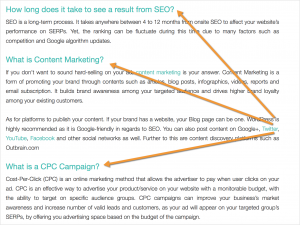Starting a small business takes grit, passion, determination, and focus. Coming up with an idea that is profitable and fills a market need is no small feat. However, once a business is up and running, ideally with a business plan in hand, it’s time to enter into the next phase of development: creating a marketing plan. Why is this the next step for small businesses? Mostly because when a business is on the cusp of launching, its primary concerns are around feasibility and operational issues. Marketing typically comes onto the scene after a business is functioning and has the bandwidth to think about growth and awareness tactics.
This doesn’t mean that a business has to save its marketing plan for after its launch. The optimal way to start a venture is with a business plan and a complementary marketing plan. If this wasn’t the case for your small business, there’s no need to fret. There is always time to bring a more strategic approach to your small business marketing efforts.
If you’re are the point where marketing is rising on your business priorities list, this post is for you. We’ll go through the essential components of a marketing plan so you have an actionable document to help achieve your overarching business goals. Are you ready? Let’s hop to it.
The 4 P’s of Marketing
If you’re a marketing novice or just need a refresher, the 4 P’s of marketing should be your guiding light for your marketing plan. The 4 P’s are product, price, place, and promotion. These four considerations are the foundation for any marketing strategy. If you keep these four elements of marketing in mind and integrate them into your plan, you can’t go wrong. Below is a brief summary of the 4 P’s and how they relate to your business.

image courtesy of SmartDraw
By keeping the 4 P’s as the framework for your marketing plan, your initiatives, strategies, and goals will seamlessly align with your business plan objectives.
With the 4 P’s as your point of reference, we can get into the five components of a small business marketing plan. Each component builds off of the other and creates a pathway for your marketing efforts. Taking the time to develop a thoughtful marketing plan will save you time and resources in the long run.
Goals
Your goals are your north star for your marketing plan. Without them, what are you doing? Clearly defining your goals and writing them down is your first step in building a sound plan. Go through your business plan and filter out larger objectives that can be supported through marketing efforts. Identify those opportunities and turn them into long and short term goals. Feel free to add dates, if they make sense for your goals and help keep you on schedule.
If your business plan is out of date, a good question to ask yourself is: what problem can my business solve for my target audience? This will guide you in the right direction for determining goals and assist in forming your plan.
Research
With the “why” now answered in the goals section, you can dig into the research portion of your plan. Use this part to delineate your current market standing, target audience, and competitive challenges. It puts a mirror in front of your face, metaphorically speaking, and forces you to see the opportunities for and gaps within your business.
For comprehensive research strategy, employ these three types of evaluation:
Perform a SWOT Analysis
SWOT, or Strengths, Weaknesses, Opportunities, and Threats, analysis is a useful tool for objectively reviewing your business. It pushes you to look at all four areas and put a stake in the ground as to where the business stands in the marketplace.
From this analysis, a business can identify areas for growth, improvements, and most importantly its Unique Selling Proposition (USP). A USP is your differentiator in the market. It’s what makes your business stand out from the rest, and is often the reason people choose your products or services over competitors. USP is an integral part of a business’s marketing efforts and should be recognizable and visible in every marketing activity.
To conduct your own SWOT analysis, use this helpful worksheet by Mind Tools.
Do Competitive Analysis
To appropriately position your business in the market, you need to know who your competitors are and what their USPs are. This basically calls for doing a SWOT analysis of your competitors. This way, you’ll have a comprehensive understanding of their strengths, weaknesses, threats, and opportunities, and you can market your business most effectively.
Pose these questions once you’ve identified your competitors:
- What is their market share?
- What are their basic objectives?
- What were their past strategies?
- What are their current strategies?
- What type of media do they use to market their products or services?
- What are their strengths and weaknesses?
- What potential threats do they pose?
- What potential opportunities do they make available for you?
Most of this information can be found in your competitor’s marketing materials, such as brochures, email campaigns, websites, and through search engines research, such as where they rank in Google searches for specific key words.
Create Buyer Personas
A buyer persona is a “fictional representation of your ideal customer based on market research and real data about your existing customers.” Personas help break down your target audience into smaller buckets, which allow for more accurate target marketing to specific groups based on a number of defining factors.
Common insights for building buyer personas include demographics, location, purchase behavior, motivations, and needs. These factors provide hard data that can be synthesized to better understand your target audience subsets. With precise buyer personas, your business is equipped to hone in on your customer’s needs and communicate your product or service-based solutions in the most valuable way.
The Buyer Persona Institute has great examples of buyer personas, which can assist you in your creation process. One sample persona is below, but if you’re interested in an extensive buyer persona profile, download this guide.
image courtesy of Buyer Persona Institute
Another helpful resource is HubSpot’s Buyer Persona Word Doc Generator, which develops personalized personas in real time by answering a series of questions. Try it today!
Strategy
Marketing strategies are ways to add a tangibility to your desired outcomes. With your goals clearly outlined, and an understanding of your positioning in the marketplace, you can develop strategies to support your business objectives. In essence, they are wide pathways to achieving your larger marketing and business objectives.
A few common marketing strategy ideas are:
- Building a recognizable brand, both in print and digitally
- Creating a SEO strategy
- Establishing a content strategy
- Expanded distribution
- Having an optimized website
- New product and service releases
As you can see, marketing strategies leave room for interpretation, as you will likely need multiple tactics to successfully realize your strategies. Given your marketing budget, your market share, the type of business, and a host of other factors, choose the top three to five strategies that work best for you.
Tactics
As was mentioned above, tactics are the “how” of your marketing plan. This is where you get nitty gritty, and define the actions that will bring your strategy to life. Think about tactics as the most efficient means to reaching your customers. It’s helpful to attach measurements to marketing tactics, so you can objectively evaluate ROI and determine which were successful or not.
Again, your business is unique and your tactics will be as distinctive as your strategies. However, here are a handful of common tactics to get you started:
- A social media presence
- Advertise, both in print and digitally
- Events
- Loyalty programs
- Promotions, online and offline
- Public Relations
- Referral programs
- Write a business blog
With your tactics in place, your marketing plan becomes more actionable and serves useful resource for your entire business. Revisit your tactics often, as new ideas arise and you’ll want them documented in your marketing plan.
Channels
The last piece of the marketing plan puzzle is your channels of distribution. This section addresses where you are actually going to market your business. It may seem like a given but writing down how you’ll use different channels makes it more clear, comprehensive, and cohesive. By formalizing your channel process, you create a holistic view of channel activity, and can ensure each platform gets the proportionate amount of effort and resources.
With the world being dependent upon both print and digital marketing, it’s important to have both types of channels in your marketing plan. Use this list as your jumping off point for creating your channel strategy:
- Direct mail
- Email marketing
- SEO
- Social media
- Website
Marketing plans are incredibly useful for businesses of any size. Knowing and understanding the components of a sound marketing plan means your small business is positioned for success. Once you are ready to take on strategic marketing, put your plan together and reap the rewards of your work for months and years to come.
Business & Finance Articles on Business 2 Community(601)










